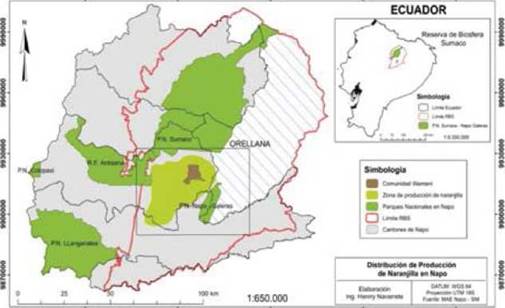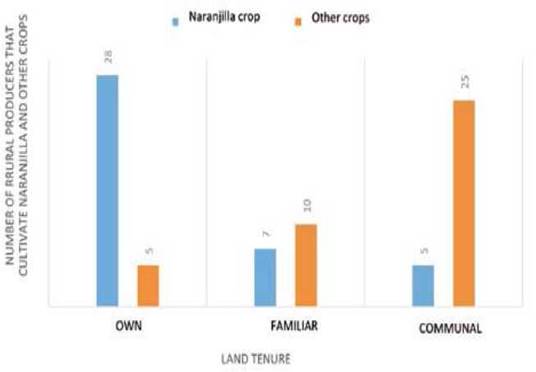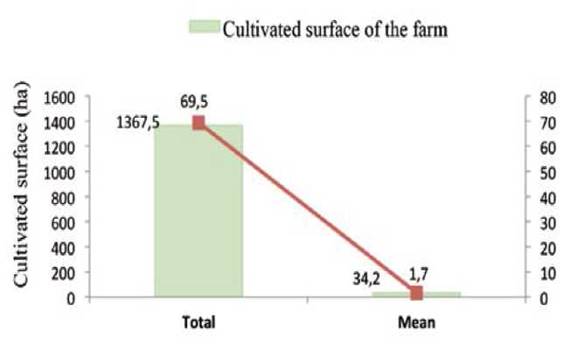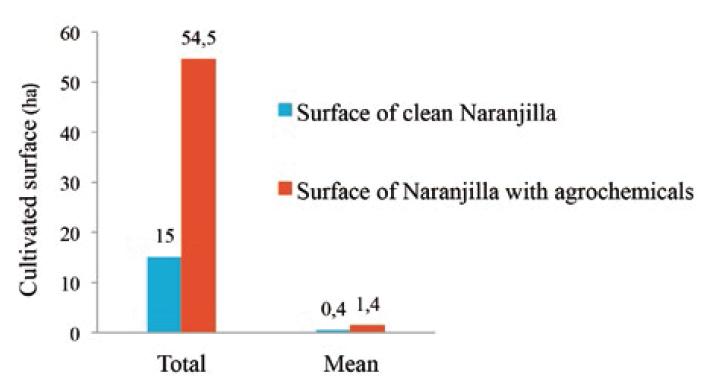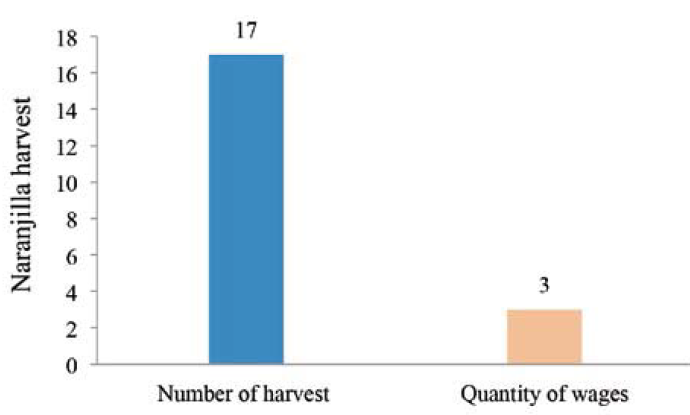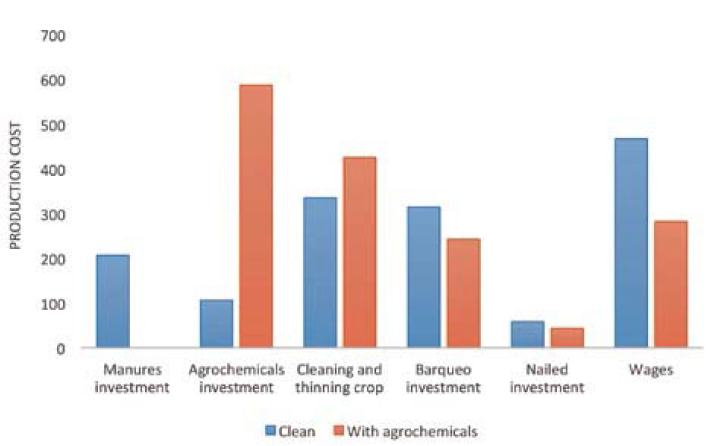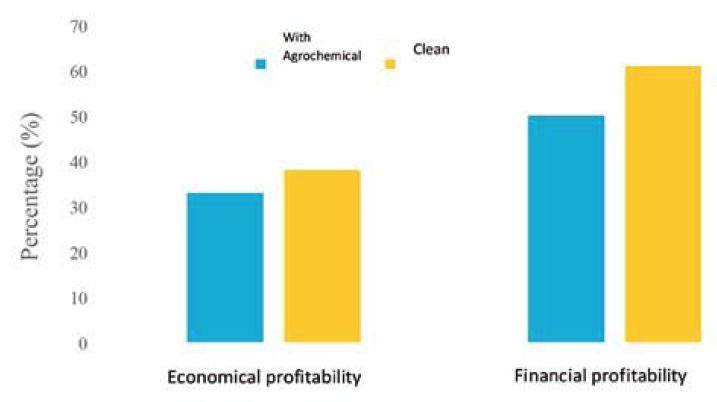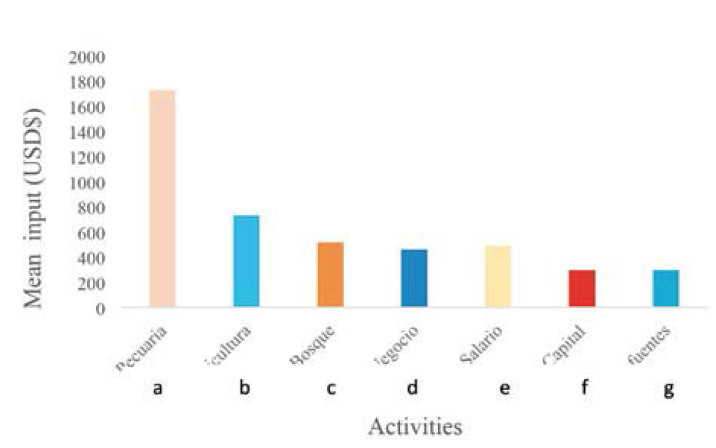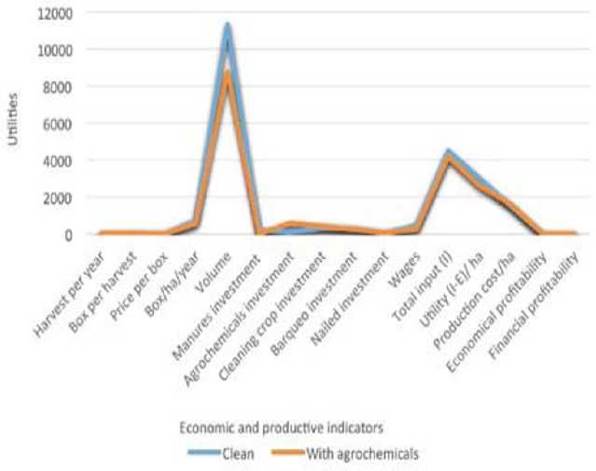Influence of socioeconomic variables in the naranjilla (Solanum quitoense Lam.) production in the rural community of Wamani in the Ecuadorian Amazon
Influencia de variables socieconómicas en la producción de naranjilla (Solanum quitoense Lam.) en la comunidad rural de Wamaní en la Amazonía Ecuatoriana
DOI:
https://doi.org/10.15446/acag.v67n1.62864Palabras clave:
Agroecosystems, crop management, economic input, rural economy, rural producers, socio-economic indicators, sustainable rural development (en)Agroecosistemas, desarrollo rural sostenible, economía rural, indicadores socio-económicos, manejo del cultivo, productores rurales, rubro económico. (es)
Descargas
Naranjilla (Solanum quitoense Lam.), is an economic input of vital importance for the Ecuadorian Amazon due to multiple benefits that offers, although it requires studies that provide a basis for the naranjilla cultivation management. The aim of this research was to determine the influence of socioeconomic variables on the naranjilla production from the rural community of Wamani, Napo province in the Ecuadorian Amazon. For the study, a group-type questionnaire was conducted to 40 rural producers of naranjilla in the region, which was structured based on three levels, which included data on the property, crop management and socio-economic aspects. Additionally, a factor analysis was applied to reduce the variables dimensionality. The results showed a pattern of own land distribution which is favorable to develop the family economy. It was found that naranjilla cultivation is the most important item in the community, although there are other crops that guarantee the diversification of the productive systems, which is reflected in the socioeconomic indicators. The T-test of independent samples, indicated that there are no significant differences among indicators for clean and chemical crop management (p≥0.05), which demonstrates the feasibility of use for the cultivation of clean naranjilla as a healthier product with additional benefits for rural producers. The factorial analysis have allowed the reduction of the 16 evaluated variables in three components associated with the economic, social and productive indicators, which explained 79.46% of the total accumulated variance.
La naranjilla (Solanum quitoense Lam.), constituye un rubro económico de vital importancia para la Amazonía ecuatoriana debido a los múltiples beneficios que brinda, aunque requiere de estudios que permitan fundamentar las bases para el manejo del cultivo de la naranjilla. El objetivo de esta investigación fue determinar la influencia de variables socioeconómicas en la producción de naranjilla de la comunidad de Wamaní, provincia Napo en la Amazonía Ecuatoriana. Para el estudio, se realizó un cuestionario de tipo grupal a 40 productores de naranjilla en la región, el cual se estructuró con base a tres niveles, los cuales comprendieron datos sobre la propiedad, manejo del cultivo y aspectos socio-económicos. Adicionalmente, se aplicó un análisis factorial para reducir la dimensionalidad de las variables. Los resultados mostraron un patrón de distribución de tierras propio lo cual es favorable para desarrollar la economía familiar. Se constató que el cultivo de la naranjilla es el rubro de mayor importancia en la comunidad aunque existen otros cultivos que garantizan la diversificación de los sistemas productivos lo cual se refleja en los indicadores socieconómicos. La prueba T de muestras independientes, indicó que no existen diferencias significativas entre los indicadores para la forma de manejo limpia y con químicos (p≥0.05), lo que demuestra la factibilidad de uso para el cultivo de naranjilla limpia como un producto más sano con beneficios adicionales para los productores rurales. El análisis factorial permitió la reducción de las 16 variables estudiadas en tres componentes asociados a lo económico, social y productivo, que explicaron el 79.46% de la varianza total acumulada.
Recibido: 22 de febrero de 2017; Aceptado: 16 de septiembre de 2017
Abstract
Naranjilla (Solanum quitoense Lam.), is an economic input of vital importance for the Ecuadorian Amazon due to multiple benefits that offers, although it requires studies that provide a basis for the naranjilla cultivation management. The aim of this research was to determine the influence of socioeconomic variables on the naranjilla production from the rural community of Wamani, Napo province in the Ecuadorian Amazon. For the study, a group-type questionnaire was conducted to 40 rural producers of naranjilla in the region, which was structured based on three levels, which included data on the property, crop management and socio-economic aspects. Additionally, a factor analysis was applied to reduce the variables dimensionality. The results showed a pattern of own land distribution which is favorable to develop the family economy. It was found that naranjilla cultivation is the most important item in the community, although there are other crops that guarantee the diversification of the productive systems, which is reflected in the socioeconomic indicators. The T-test of independent samples, indicated that there are no significant differences among indicators for clean and chemical crop management (p>0.05), which demonstrates the feasibility of use for the cultivation of clean naranjilla as a healthier product with additional benefits for rural producers. The factorial analysis have allowed the reduction of the 16 evaluated variables in three components associated with the economic, social and productive indicators, which explained 79.46% of the total accumulated variance.
Key words:
Agroecosystems, crop management, economic input, rural economy, rural producers, socio-economic indicators, sustainable rural development.Resumen
La naranjilla (Solanum quitoense Lam.), constituye un rubro económico de vital importancia para la Amazonía ecuatoriana debido a los múltiples beneficios que brinda, aunque requiere de estudios que permitan fundamentar las bases para el manejo del cultivo de la naranjilla. El objetivo de esta investigación fue determinar la influencia de variables socioeconómicas en la producción de naranjilla de la comunidad de Wamaní, provincia Napo en la Amazonía Ecuatoriana. Para el estudio, se realizó un cuestionario de tipo grupal a 40 productores de naranjilla en la región, el cual se estructuró con base a tres niveles, los cuales comprendieron datos sobre la propiedad, manejo del cultivo y aspectos socio-económicos. Adicionalmente, se aplicó un análisis factorial para reducir la dimensionalidad de las variables. Los resultados mostraron un patrón de distribución de tierras propio lo cual es favorable para desarrollar la economía familiar. Se constató que el cultivo de la naranjilla es el rubro de mayor importancia en la comunidad aunque existen otros cultivos que garantizan la diversificación de los sistemas productivos lo cual se refleja en los indicadores socieconómicos. La prueba T de muestras independientes, indicó que no existen diferencias significativas entre los indicadores para la forma de manejo limpia y con químicos (p>0.05), lo que demuestra la factibilidad de uso para el cultivo de naranjilla limpia como un producto más sano con beneficios adicionales para los productores rurales. El análisis factorial permitió la reducción de las 16 variables estudiadas en tres componentes asociados a lo económico, social y productivo, que explicaron el 79.46% de la varianza total acumulada.
Palabras clave:
Agroecosistemas, desarrollo rural sostenible, economía rural, indicadores socio-económicos, manejo del cultivo, productores rurales, rubro económico.Introduction
Under the current globalization conditions, paradigm changes in the agricultural sector are increasingly important in order to allow the restructuring of agricultural production schemes throughout social, economic and environmental transformations.
Ecuador, is an eminently agricultural country where the agricultural sector is and will continue to be the true productive engine of the Ecuadorian economy. The agricultural activity generates multiplier effects for the economy, hence its social importance as it provides sources of employment (FAO, 2000).
The Amazon region of Ecuador has a transcendental importance in the socioeconomic development of the country due to the productive potential and the accelerated settlement experienced by population movements from other regions in Ecuador. The possibility of integrating the Ecuadorian Amazon into the socioeconomic and productive system at the national level and above all the search for alternatives aimed at improving the agro-productive chain makes it essential to increase the production of promising species with high potential for food, in addition to the considerable natural advantages that must be used to obtain productions according to the Amazonian conditions. S. quitoense, is an interesting and attractive member of the Solanaceae family with high potential for this purpose.
Naranjilla is a herbaceous shrub, with thick stems that becomes somewhat woody with age; thorny in nature and without thorns in cultivated plants. This fruit shrub is native from subtropical understories of the Andes of Ecuador, where it grows from 800 to 1400 m.a.s.l., is also cultivated in Colombia, Peru, Panama, Costa Rica and Peru. (Ochoa, Balaguera, Ardila, Pinzón & Álvarez, 2016)2016. Naranjilla is a very aromatic fruit with a bittersweet flavor and a high content of vitamins, proteins, carotenes, phenolic compounds and minerals. (Forero, Orrego, Peterson & Osorio, 2015; Gancel, Alter, Dhuique, Ruales & Vaillant, 2008; Revelo & Sandoval, 2003) and also highly demanded in national and international markets (Medina, Lobo, & Martínez, 2009; Arias & Rendón, 2014; Torres,Starnfeld,Vargas, Ramm, Chapalbay, Rios, Jurrius, Gómez, Torricelli & Tapia, 2014). In Ecuador, 10000 ha are destined to naranjilla sowing in the outer foothills of the cordillera and Amazon plain, 17% of the Amazon is dedicated to the production of this exotic fruit ( Schiffman & Kanuk, 2005).
The current conditions of the S. quitoense cultivation have put at risk the economic, environmental and health welfare of the producers and consumers, mainly due to the indiscriminate use of agrochemicals, in addition to the high rate of deforestation due to the native forest destruction for the establishment of new Naranjilla production areas, the indiscriminate use of pesticides for pest control, which affects the crop cycle duration, the fruit yield and quality. Therefore, is necessary to resize the productive matrix that promotes changes in an efficient way in the economic-productive and environmental contexts sustained in the framework of an articulating process of local development that allows to base scientific bases for crop management.
Given these concerns, the aim of this study was to determine the influence of socioeconomic variables on the production of Solanum quitoense Lam. from the rural community of Wamani, Napo province, Ecuador.
Materials and methods
Study area
The research was conducted in the rural community of Wamani, Jatun Sumaku parish, Archidona canton, Napo-Ecuador province, located in the buffer and transition areas of the Sumaco biosphere reserve (Figure 1) in the foothills of the Sumaco Volcano protective forest within the forest heritage of the Sumaco Napo-Galeras National Park, Ecuador. The study area is bordered to the north by the Quijos canton, to the south by the Cotundo parish, to the east by the Loreto canton and to the west by the Cotundo parish, from the mouth of the unnamed estuary to the Chaluayacu river and is located between the following geographical coordinates 209.139.4E and 9.920.325.7N at 1200 m.a.s.l.
Figure 1: Geographical location of the study area
Sample selection and questionnaire application
In order to characterize socio-economic and productive aspects of the naranjilla crop, a survey method was used, from which, a semi-structured group-type questionnaire was carried out characterized according to Notario-de la Torre (2004), to contain heading with a request for cooperation, truthfulness and to be applied at the appropriate place and time to obtain greater collaboration, with a language appropriate to the level of Naranjilla producers in the study area. The form was structured in three levels that include data on property, crop management and economic aspects, and these, in turn, were structured into questions, which, according to the objective, were essential (those directly related to the problem at solve and defined objectives), according to their nature, were of intention or opinion (those related to the purpose, decisions, projects, judgments, assessments and criticisms of the respondents) and according to the form were semi-closed (provided by predesigned responses but also made it possible to issue a response not contained in the guide or clarifications, deepening and abstentions), which allowed as an empirical method of sensory perception to reduce the bias of the information.
A pre-test or pre-test was applied to a preliminary sample of 20 individuals, in order to adjust the questionnaire as explained by Hernández, Fernandez & Baptista (2003), this have allowed to obtain complementary elements about the problem, introducing or excluding indicators and redesigning questions. After carrying out the previous test and redesigning the questionnaire, it was applied to 40 producers of Naranjilla in the study area. The sample size was determined based on the established population (Calero, 1985), with a confidence margin of 10%, which proved reliable to had achieved the proposed objective.
Statistic analysis
A nonparametric T test of independent samples was carried out to verify if there were significant differences between the assumed categories of socioeconomic and productive indicators of the naranjilla in different management forms (clean and conventional), with a level of reliability of 95% (p< 0.005), this was possible with the use of the statistical package SPSS ver. 21.0.TM
Therefore, a factorial analysis was performed as a multivariate technique, which have allowed to identify the underlying factors or the dimensions that reflect what the variables share in common, from which, it was found that the original variables obtained from the study, were correlated among each other. The variables included in the study were as follows: Naranjilla surface, technical assistance, production cost, production volume, crop boxes, utility, income and investment per crop, profitability, harvests per year, boxes per year, price per box, box.ha-1. year-1, total income, total investment and profit in one year, respectively (Table 1).
Table 1: Variables included in the factorial analysis
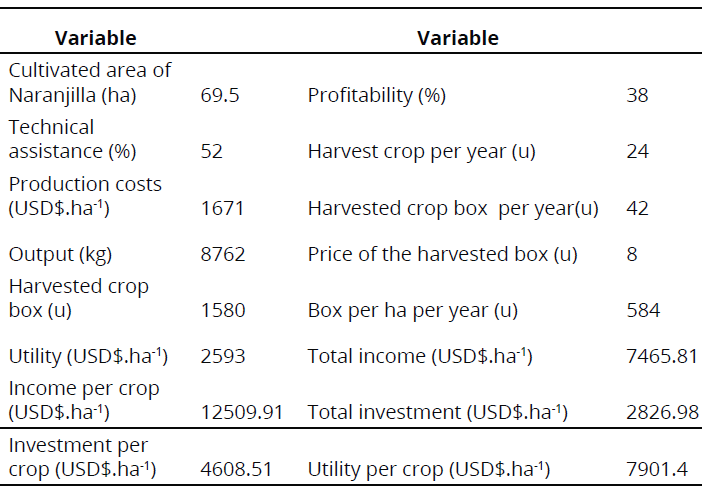
Results
Socioeconomic and productive characterization of the Naranjilla crop
In the rural community of Wamani, data on land tenure indicated that 70% own land; 14% are communal lands and 16% correspond to family lands (inheritance). This reflects a pattern of own land distribution which is favorable for the Naranjilla crop continuity in the study area.
Percentage information on tenure was complemented with land use (Figure 2), indicating that the category of own tenure corresponded, mostly, to the use of the Naranjilla cultivation, while the communal and family lands are dedicated to other crops, such as cassava, plantain, pastures, among others.
Figure 2: Number of producers for land tenure that are dedicated to Naranjilla and other crops
From Figure 2, can be argued that the economy of the rural producer is not based exclusively on the Naranjilla cultivation, although from the total area of land (1367.5 ha), the rural producers of the Wamani community allocate 69.5 ha to Naranjilla crop (Figure 3).
Figure 3: Total area of the producing farm and Naranjilla crop
Emphasizing the ways of Naranjilla crop management, from the hectares dedicated to Naranjilla crop, 1.4 ha on average, they are cultivated in a conventional manner, which is, with the use of agrochemicals; while only 0.4 ha are cultivated in a clean manner, using organic fertilizers made by the same producers (Figure 4).
Figure 4: Total and mean surface area of Naranjilla crop
In relation to Naranjilla harvest, is carried out manually from the eight months of sowing. This labor is carried out on average 17 times a year, and they use three wages per harvest (Figure 5). These results demonstrate the potentialities of the species, resulting in an alternative to improve the family economy.
Figure 5: Number of harvest per year and wages used per Naranjilla harvest
It is notorious that the production costs (ha.year-1) in relation to analyzed outputs, were higher for the conventional Naranjilla crop (Figure 6).
Figure 6: Production cost of clean Naranjilla crop and with agrochemicals per ha.year-1
In Figure 7, the levels of economic and financial profitability of the Naranjilla clean crop and with agrochemicals are represented, verifying that the clean management way is more profitable, which is a reflection of the value and cost production behavior of the Naranjilla crop. Subsequently, the profitability percentages were low.
Figure 7: Economical and financial profitability of clean Naranjilla crop and with agrochemicals per ha.year-1
In Figure 8, the behavior of the average crop input is presented by different activities. Livestock activity was the highest input.
Figure 8: Behavior of the mean input per activities. a) livestock; b) agriculture; c) forest; d) agribusiness; e) wage; f capital; g) other sources.
Figure 9: Behavior of productive and economic indicators for clean Naranjilla crop and with agrochemicals.
Comparative analysis of the indicators with management crop
The performance of the productive and economic indicators from Naranjilla crop for both forms of clean and conventional management is shown in Figure 9. The T test for independent samples indicated that there are no significant differences among indicators (p> 0.05).
Analysis of the variables dimensionality
The factorial analysis showed that the variables share common factors. The "commonality" of each variable is what explains the factors and what determines that there is a relationship between each pair of variables that form the set of the original variables. Table 2, shows the analysis of communalities as estimates of the shared or common variance among variables.
Table 2: Analysis of communalities
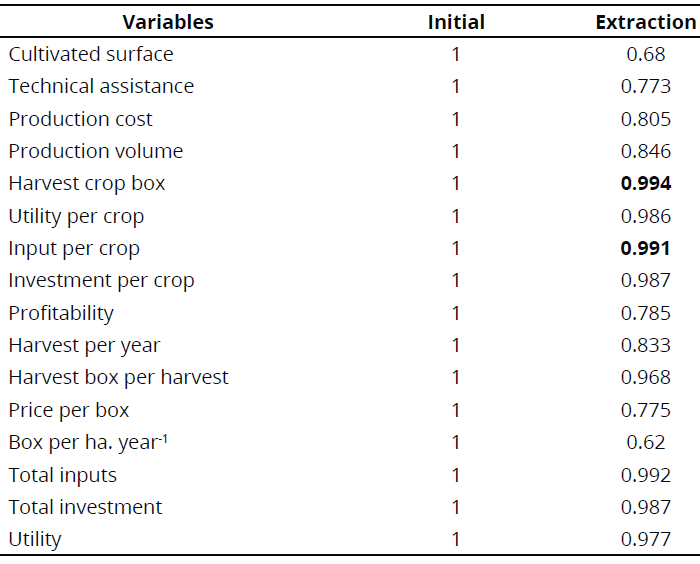
Table 3, shows the total variance matrix explained. The results show that there are four components with eigenvalues greater than one but those factors which explained 79.46% from the total cumulative variance (three components), which were selected and pooled for subsequent analyses.
Table 3: Matrix of total explained variance
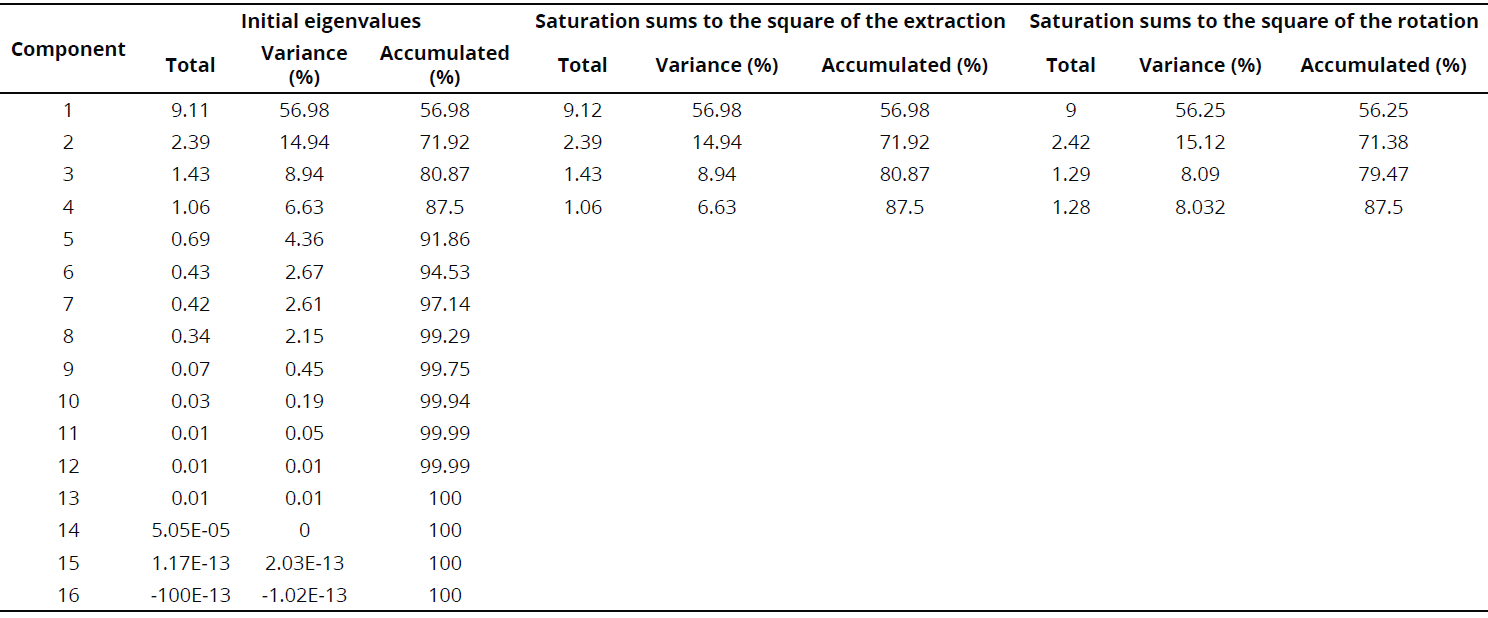
Table 4, shows the matrix of principal components vs. the selection of three components. The first group includes variables related to productive activity (area, production volume, harvest crop boxes, utility, input and investment for crops, input per crop, income per ha.year-1, total input, total investment and profitability), The second component is associated with the economic factor (production cost, profitability and market price) and third with the social factor (technical assistance and harvests per year). The factors were selected to explain the interrelationships among variables and reduce them. It is noteworthy that the first component grouped those variables of productive activity directly related to the Naranjilla crop production and other crops that are produced in the study area as follows: forest crops, plantain, cassava and pastures, respectively. Faced with the current scenario of other crops that are produced in the study area, Naranjilla, shows greater relevance to the economy of the Wamani community producers. In the second component, the relationship of the variables is evident due to profitability is determined through production cost and in the third, there are the variables that most relate with the social conditions of the inhabitants, evidencing that the 52% has received technical assistance for crop management and this is reflected in the harvests per year.
Table 4: Matrix of principal components
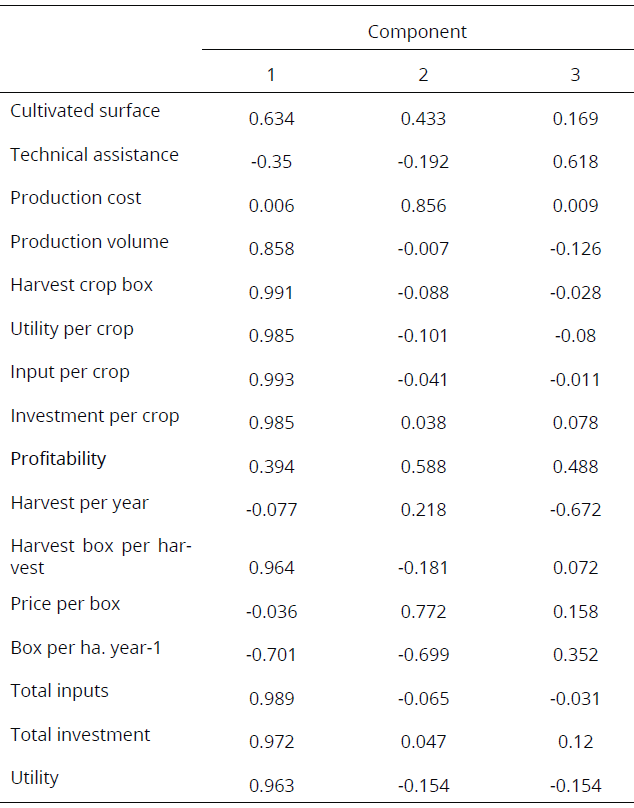
Discussion
The data reported here of land tenure, contrast with what was proposed by OAS (2006), which refers to the marked pattern of land tenure in Latin America and the Caribbean, where is stated that most of the arable land is in hands of the landed elite and the state under unproductive latifundia, while peasants and small farmers practicing subsistence agriculture are concentrated in smallholdings and marginal lands.
The land is a productive resource, fundamental of agricultural, livestock and forestry activities and therefore, is a very important factor in the economies of these activities.
On the other hand, 5.08% of the use of arable land corresponded to Naranjilla crop and although in relative terms is not very representative, the area destined to the Naranjilla crop production is notable, which indicates that is a highly important economic item in the farms that contributes to the income family and food. (Revelo & Sandoval, 2003) in a study on the factors that affect the Naranjilla production and productivity in the Amazon Region of Ecuador, refers to the Naranjilla importance as an economic item that directly influences the family income and contributing to improve the quality of life.
From the information condensed in Figure 4, can be seen that these results show an incipient process in the Naranjilla clean crop, which is due to the lack of a technological culture in the productive systems as a predominant feature in peasant economies.
Accordingly to Revelo, Viteri, Vásquez, León & Gallegos (2010), the practices in the Naranjilla crop management, are still pioneering, due to the same technology is maintained in all the Amazonian provinces, differentiating only by the cultivated surface or the cultivar used, which shows that there has been no good technology transfer.
Farmers handle the crop in a conventional manner and use an inadequate mixture of toxic agrochemicals such as carbofuran, methamidophos and 2.4-D (internationally banned products and the first two, particularly in Ecuador). Revelo, Viteri, Vásquez, León & Gallegos (2010), state that the use of agrochemicals endangers the health of farmers, affects the environment and increases costs unnecessarily.
In addition, is important to note that Local initiatives should be used to boost clean production that provides lower costs. These results coincide with what was reported by Torres, Vargas, Quintana & Arteaga (2016). Agriculture as an economic activity can only be sustained if is profitable and for this to be possible, it must consist of an agribusiness vision in correspondence with the current market demands.
This corresponds to Vallejo, Franco & Cuero (2013), who report that the low profitability of the Naranjilla crop in Jatun Sumaku, obeys to multiple factors associated with crop management and consequently to the area destined to the crop, which had achieved a decreasing cultivated area in recent years to promote new products such as guayusa.
Lacki (2011), affirms that this crop is of great economic potential due to its high profitability and acceptance in the market. In fact, Fiallos (2000), argues that if the crop had achieved an adequate and technified management, can generate a return of 164%, while Revelo, Viteri, Vásquez, León & Gallegos (2010), estimate a profitability of 119%.
The results of this study indicate that agricultural activity plays a fundamental role within the activities that generate income in the Wamani community and within this, the Naranjilla crop is the most represented crop. Although income is not a complete measure of economic well-being, is an important indicator to measure this purpose (Robeyns, 2005). These results demonstrate the feasibility of promoting the use of clean naranjilla as a healthier product with additional benefits for producers.
From Table 2, indican resultados dentro de los cuales, se exponen las variables que mejor explican el modelo, los cuales son las cajas de cultivo, ingresos por cultivos y el total del ingreso. Conversely, the worst explanation is the harvest box variable per ha.year-1, although all the variables were included in the analysis of the number of factors because they present a high proportion of their variance (extraction). This was possible based on the criteria presented by Pérez (2004), in relation to the inclusion of variables in the analysis of communalities.
Conclusion
The Naranjilla production in the Wamani community of the Ecuadorian Amazon is an important item for the family economy, with a predominant pattern of land distribution that favors the crop development and consequently, is reflected in the socioeconomic and productive indicators, and although clean Naranjilla management practices are pioneers at the local level, is feasible to use them as a healthier product with greater benefits that contributes substantially to the quality of life.
References
Referencias
Arias, V. F. & Rendón, S.S. (2014). Inteligencia de mercados para la cadena del lulo (Solanum quitoense). J Agric Anim Sci, 3(2). http://repository.lasallista.edu.co:8080/ojs/index.php/jals/article/view/732/517.
Calero, V. A. (1985). Estadística I, II y III. Editorial Pueblo y Educación. La Habana, Cuba. 185 p.
FAO- Food and Agriculture Organization. (2000). La agricultura hacia el año 2015/30. Informe técnico para FAO. Quito, Ecuador. http://www.fao.org/3/a-y3557s.pdf.
Fiallos, J. (2000). Naranjilla INIAP-Palora: Híbrido interespecífico de alto rendimiento. Boletín divulgativo No. 26. INIAP(Eds.)http://www.iniap.gob.ec/nsite/images/documentos/Naranjilla%20INIAP%20PALORA.%20H%C3%ADbrido%20interespecifico%20de%20alto%20renimiento..pdf.
Forero, D. P., Orrego, C. E., Peterson, D.G. & Osorio, C. (2015). Chemical and sensory comparison of fresh and dried lulo (Solanum quitoense Lam.) fruit aroma. Food chem, 169, 85-91. https://doi.org/10.1016/j.foodchem.2014.07.111
Gancel, A.L., Alter, P., Dhuique-Mayer, C., Ruales, J. & Vaillant, F. (2008). Identifying carotenoids and phenolic compounds in naranjilla (Solanum quitoense Lam. var. Puyo hybrid), an Andean fruit. J Agr Food Chem, 56(24), 11890-11899. https://doi.org/ 10.1021/jf801515p
Hernández-Sampieri, R., Fernández-Collado, C. & Baptista, L.P. (2003). Metodología de la investigación. Vol.1. Félix Varela (Eds.), La Habana, Cuba. 19 p.
Lacki, P. (2011). El libro de los pobres rurales. Desarrollo agropecuario: de la dependencia al protagonismo del agricultor. Curitiba - Paraná - Brasil. http://www.pehcbm.gob.pe/files/pobresrurales.pdf.
Medina, C. I., Lobo, M. & Martínez, E. (2009). Revisión del estado del conocimiento sobre la función productiva del lulo (Solanum quitoense Lam.) en Colombia. Corpoica Cienc Tecnol Agropecu, 10(2),167-179. https://doi.org/10.21930/rcta.vol10_num2_art:139
Notario-de la Torre, Á. (2004). Investigación Científica en las instituciones de educación Superior. Medellín, Colombia: Colección Autores Esumer, serie Formación.
OAS-Organización de los Estados Americanos. (2006). Tenencia de la tierra: Compartiendo información y experiencias para la sostenibilidad. Serie de Políticas, 10. 1-4. https://www.oas.org/dsd/policy_series/10_spa.pdf.
Ochoa-Vargas, L.M., Balaguera-López, H.E., Ardila-Roa, G. Pinzón-Sandoval, E. H. & Álvarez-Herrera, J. G. (2016). Growth and development of Lulo (Solanum quitoense Lam.) in the municipality of San Antonio del Tequendama (Colombia). Corpoica Cienc Tecnol Agropecu, 17(3), 347-359. https://doi.org/10.21930/rcta.vol17_num3_art:512
Pérez, L. C. (2004). Técnicas de análisis multivariante de datos. Aplicaciones con SPSS. 5. Pearson-Prentice Hall (Eds.). Madrid, España. 672p.
Revelo, J. & Sandoval, P. (2003). Factores que afectan la producción y productividad de la naranjilla (Solanum quitoense Lam.) en la Región Amazónica del Ecuador. INIAP- Instituto Nacional de Investigaciones Agropecuarias (Eds.). Quito, Ecuador. 59p. http://repositorio.iniap.gob.ec/handle/41000/2434.
Revelo. J.Viteri. P. Vásquez W. León J. Gallegos. P. (2010). Manual del cultivo ecológico de la naranjilla. INIAP- Instituto Nacional de Investigaciones Agropecuarias (Eds.). Quito, Ecuador. 120p.
Robeyns, I. (2005). The capability approach: a theoretical survey. J Hum Dev, 6(1), 93-117. https://doi.org/10.1080/146498805200034266
Schiffman, L. G., & Kanuk, L. L. (2005). Comportamiento del consumidor. 10th Edition..Pearson (Eds.). 100 p.
Torres, A. Vargas, J.C., Quintana, Y. & Arteaga, Y. (2016). Socio-economic and agrarian history of the Jatun Sumaco communities in the Ecuadorian Amazon. Int J Agric Life Sci, 2(3), 48-53. https://doi.org/10.9379/sf.ijals
Torres, B., Starnfeld, F. Vargas, J.C., Ramm, G., Chapalbay, R., Rios, M., Jurrius, I., Gómez, A., Torricelli, Y. & Tapia, A. (2014). Gobernanza participativa en la Amazonía del Ecuador: recursos naturales y desarrollo sostenible. Universidad Estatal Amazónica (Eds.), Puyo, Pastaza, Ecuador. http://www.plantasutilesdeltropico.com/wp-content/uploads/2015/02/Gobernanza-participativa-en-la-Amazon%C3%ADa-del-Ecuador-recursos-naturales-y-desarrollo-sostenible.pdf.
Vallejo, L., Franco, S. & Cuero, E. (2013). Caracterización socioeconómica y uso del bosque en la parroquia Jatun Sumaco. Rainforest Alliance & Ecolex (Eds.). Quito, Ecuador. 59p.
Cómo citar
APA
ACM
ACS
ABNT
Chicago
Harvard
IEEE
MLA
Turabian
Vancouver
Descargar cita
CrossRef Cited-by
1. Yadira Vargas, William Viera, Alejandra Díaz, Leider Tinoco, Julio Macas, Carlos Caicedo, Marcelo Almeida, Wilson Vásquez-Castillo. (2022). Contribution of Agroforestry Systems in the Cultivation of Naranjilla (Solanum quitoense) Grown in the Amazon Region of Ecuador. Applied Sciences, 12(20), p.10637. https://doi.org/10.3390/app122010637.
2. William Viera, Alejandra Díaz, Carlos Caicedo, Alfonso Suárez, Yadira Vargas. (2021). Key Agronomic Fertilization Practices That Influence Yield of Naranjilla (Solanum quitoense Lam.) in the Ecuadorian Amazon. Agronomy, 11(2), p.310. https://doi.org/10.3390/agronomy11020310.
3. Cristian Vasco, Bolier Torres, Estefanía Jácome, Alexandra Torres, David Eche, Christian Velasco. (2021). Use of chemical fertilizers and pesticides in frontier areas: A case study in the Northern Ecuadorian Amazon. Land Use Policy, 107, p.105490. https://doi.org/10.1016/j.landusepol.2021.105490.
Dimensions
PlumX
Visitas a la página del resumen del artículo
Descargas
Licencia
Derechos de autor 2018 Acta Agronómica

Esta obra está bajo una licencia internacional Creative Commons Atribución-NoComercial-SinDerivadas 4.0.
Política sobre Derechos de autor:Los autores que publican en la revista se acogen al código de licencia creative commons 4.0 de atribución, no comercial, sin derivados.
Es decir, que aún siendo la Revista Acta Agronómica de acceso libre, los usuarios pueden descargar la información contenida en ella, pero deben darle atribución o reconocimiento de propiedad intelectual, deben usarlo tal como está, sin derivación alguna y no debe ser usado con fines comerciales.




